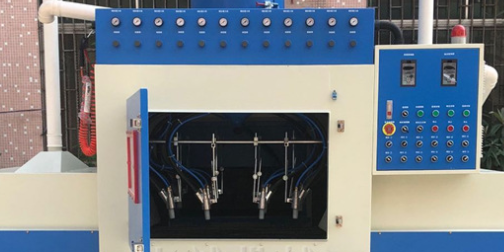Process parameters of sandblasting machine for composite metal materials
Commonly used metal materials for aviation and aerospace vehicles include steel, titanium alloy, and aluminum alloy. Titanium alloy has good heat resistance, low temperature toughness and fracture toughness. It is called "aerospace metal". It is mostly used as aircraft structural parts and bonded with composite materials. The thermal expansion coefficient of the two is close and the matching is good; the aluminum alloy is light in weight , The lightweight effect is significant. It is mainly used in satellite payload bays, solar wing substrates and fuel pressure vessel linings. The main connection method of aluminum alloy and composite parts is glued; steel materials are used because of their good comprehensive mechanical properties. Used as engine support material for bonding composite insulation layers.In the process of processing, transportation and storage, the surface of these metal materials has oily oxide layer dust and other extras. If used directly, it will affect the stability of the aircraft on orbit, and the bonding layer of metal materials and composite materials is easy to debond, causing serious consequences. The pretreatment method of metal surface is mainly mechanical treatment, that is, throughSandblasting machineSandblast the surface.

Sandblasting of composite metal materials by sandblasting machine is an efficient surface treatment method. Its principle is mainly to use the impact of high-speed sand flow to clean and roughen the surface of the material, so that the surface of the material can obtain a certain degree of cleanliness and roughness. The process parameters vary depending on the material. Generally speaking, the sandblasting machine mainly blasts the metal surface to improve its surface cleanliness and roughness, and does not mechanically treat the surface of the composite material, so as not to damage the continuous fiber layer of the composite material.
Due to different metal materials, the process parameters required by the sandblasting machine are also different. The main process parameters are: 1.Abrasive thickness. Generally, the finer the abrasive, the smoother the surface obtained by sandblasting; 2.air pressure. The higher the air pressure, the higher the speed of the jet stream, and the rougher the surface of the workpiece, generally the highest pressure does not exceed 0.8MPa; 3.Sandblasting distance. The farther the spray gun of the sandblasting machine is from the workpiece, the lower the efficiency of the sandblasting flow and the smoother the surface of the workpiece. 4.Sandblasting time. Within a certain time range, the surface roughness of metal materials increases with the prolongation of the sandblasting time, but after reaching a certain surface state, the roughness remains stable. 5.Sandblasting angle. The smaller the angle between the spray gun of the sandblasting machine and the workpiece, the lower the efficiency of the jet stream and the smoother the surface of the workpiece. The sandblasting angle should not be less than 45°.

Related Industry Knowledge
- Environmental protection and energy saving sandblasting machine controls dust pollution during the sandblasting process
- Wet blasting machine with abrasive blasting
- Automatic sandblasting machine automatically refers to automatic sandblasting
- Adjustable spray pressure of small sandblasting machine
- Inhalation type sandblasting
- Design of automatic sandblasting machine with synchronous conveying of shaft inner hole and outer circle
- Talking about the research and optimization status of rust removal and sandblasting process parameters
- Mobile sandblasting machine adopts press-in sandblasting
- Sandblasting machine manufacturers provide a variety of sandblasting machines
- Matters needing attention when sandblasting machine sand blasting cupronickel casing parts
- Overview of burr machine
- The material used for the blasting of the rust removal sandblasting machine is the sandblasting abrasive
- Conveyor type automatic sandblasting machine adopts triangle belt to convey workpiece




